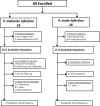In vivo and in vitro efficacy of chloroquine against Plasmodium malariae and P. ovale in Papua, Indonesia
- PMID: 20937779
- PMCID: PMC3019630
- DOI: 10.1128/AAC.01122-10
In vivo and in vitro efficacy of chloroquine against Plasmodium malariae and P. ovale in Papua, Indonesia
Abstract
Reports of potential drug-resistant strains of Plasmodium malariae in western Indonesia raise concerns that chloroquine resistance may be emerging in P. malariae and P. ovale. In order to assess this, in vivo and in vitro efficacy studies were conducted in patients with monoinfection in Papua, Indonesia. Consecutive patients with uncomplicated malaria due to P. ovale or P. malariae were enrolled in a prospective clinical trial, provided with supervised chloroquine treatment, and followed for 28 days. Blood from patients with P. malariae or P. ovale parasitemia greater than 1,000 per microliter underwent in vitro antimalarial drug susceptibility testing using a modified schizont maturation assay. Of the 57 evaluable patients in the clinical study (P. malariae, n = 46; P. ovale, n = 11), none had recurrence with the same species during follow-up. The mean parasite reduction ratio at 48 h was 86 (95% confidence interval [CI], 57 to 114) for P. malariae and 150 (95% CI, 54 to 245) for P. ovale (P = 0.18). One patient infected with P. malariae, with 93% of parasites at the trophozoite stage, was still parasitemic on day 4. In vitro drug susceptibility assays were carried out successfully for 40 isolates (34 infected with P. malariae and 6 with P. ovale). The P. malariae infections at trophozoite stages had significantly higher chloroquine 50% effective concentrations (EC(50)s) (median, 127.9 nM [range, 7.9 to 2,980]) than those initially exposed at the ring stage (median, 14.0 nM [range, 3.5 to 27.0]; P = 0.01). The EC(50) for chloroquine in P. ovale was also higher in an isolate initially at the trophozoite stage (23.2 nM) than in the three isolates predominantly at ring stage (7.8 nM). Chloroquine retains adequate efficacy against P. ovale and P. malariae, but its marked stage specificity of action may account for reports of delayed parasite clearance times.
Figures
References
-
- Barnadas, C., A. Ratsimbasoa, H. Ranaivosoa, D. Ralaizandry, D. Raveloariseheno, V. Rabekotonorina, S. Picot, and D. Menard. 2007. Short report: prevalence and chloroquine sensitivity of Plasmodium malariae in Madagascar. Am. J. Trop. Med. Hyg. 77:1039-1042. - PubMed
-
- Basco, L. K., and J. Le Bras. 1994. Short-term in vitro culture of Plasmodium vivax and P. ovale for drug-susceptibility testing. Parasitol. Res. 80:262-264. - PubMed
-
- Cavasini, M. T., W. L. Ribeiro, F. Kawamoto, and M. U. Ferreira. 2000. How prevalent is Plasmodium malariae in Rondonia, western Brazilian Amazon? Rev. Soc. Bras. Med. Trop. 33:489-492. - PubMed
-
- Collins, W. E., and G. M. Jeffery. 2002. Extended clearance time after treatment of infections with Plasmodium malariae may not be indicative of resistance to chloroquine. Am. J. Trop. Med. Hyg. 67:406-410. - PubMed
Publication types
MeSH terms
Substances
Grants and funding
LinkOut - more resources
Full Text Sources
Medical



